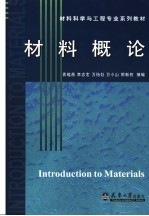

材料概论 双语PDF电子书下载
- 电子书积分:9 积分如何计算积分?
- 作 者:袁晓燕等编
- 出 版 社:天津:天津大学出版社
- 出版年份:2006
- ISBN:7561823428
- 页数:158 页
1 Introduction 1
1.1 Historical perspective 1
1.2 Classification of materials 1
1.3 Structures of metals and ceramics 2
1.3.1 Structure of metals 2
1.3.2 Structure of ceramics 6
1.4 Polymer structures 7
1.4.1 Macromolecules 7
1.4.2 Molecular weight 8
1.4.3 Molecular structures 9
Keywords 10
Problems 10
Selected from 11
2.1 Structure and properties of steel 12
2 Metal Materials 12
2.1.1 Iron-carbon alloys 13
2.1.2 Strength versus carbon content in steels 14
2.1.3 Formation of pearlite 16
2.1.4 Effect of cooling rate 20
2.1.5 Alloying elements 21
2.1.6 Selecting carbon steels 22
2.2 Heat treatment of steels 24
2.2.1 Response of steels to heat treatment 24
2.2.2 Hardenability 26
2.2.3 Surface hardening 27
2.2.4 Tempering 28
2.2.5 Choice of heat treatment 29
2.3 Stainless steels 30
2.3.1 Composition,nomenclature and general properties 30
2.3.2 Common stainless steel alloy systems 33
2.3.3 Corrosion behavior of stainless steels 34
2.4 Nonferrous alloys 39
2.4.1 Copper and its alloys 39
2.4.2 Aluminum and its alloys 41
2.4.3 Magnesium and its alloys 43
2.4.4 Titanium and its alloys 44
2.4.5 Refractory metals 45
2.4.6 Superalloys 46
2.4.7 Noble metals 46
2.4.8 Miscellaneous nonferrous alloys 46
Keywords 47
Problems 47
Selected from 48
3.1.1 Definition of ceramics 49
3.1.2 Classification of ceramics 49
3.1 Introduction to ceramics 49
3 Ceramic Materials 49
3.1.3 Overview of ceramic and glass manufacturing 50
3.1.4 Structure and properties of ceramics 51
3.1.5 History of ceramics 52
3.1.6 Impact on society 52
3.2 What are advanced ceramics 55
3.3 Structural ceramics and its development 57
3.3.1 Introduction and current status 57
3.3.2 Trends 57
3.3.3 Future work strategies 59
3.4 Electroceramics and its developing directions 60
3.4.1 What are electroceramics 60
3.4.2 Common applications for electroceramies 60
3.4.3 Fundamental research needs and developing trends for electroceramics 61
3.5 Bioceramics 65
3.5.1 Introduction 65
3.5.2 Bioinert and bioactive materials 66
3.5.3 Compatibility between bioceramics and the human environment 67
3.5.4 Most common bioceramics 68
3.5.5 Uses for bioceramics 69
3.6 Advanced ceramic materials:Summary of possible applications 71
3.6.1 Introduction 71
3.6.2 State of the art 71
3.6.3 Trends for the future 73
3.7 Advanced ceramic materials:Basic research viewpoint 78
3.7.1 Introduction 78
3.7.2 State of the art 79
3.7.3 Trends in technology 80
3.7.4 Needs for future basic research 81
Keywords 85
Problems 86
Selected from 86
4 Polymer Materials 87
4.1 Introduction 87
4.1.1 Formation 87
4.1.2 Classification 89
4.1.3 Nomenclature 90
4.1.4 History 91
4.2 Natural polymers 93
4.2.1 Polysaccharides 93
4.2.2 Proteins 96
4.3 Thermoplastics 97
4.3.1 Polyethylene 99
4.3.2 Polypropylene 105
4.3.3 Polystyrene 107
4.3.4 Poly(vinyl chloride) 108
4.4 Engineering plastics and thermosets 110
4.4.1 Nylons 111
4.4.2 Polyesters 113
4.4.3 Polycarbonates 114
4.4.4 Polysiloxanes 115
4.4.5 Epoxy resins 116
4.5 Applications of polymers 117
4.5.1 Membrane separations 118
4.5.2 Biomedical applications 123
4.5.3 Applications in electronics 126
Keywords 129
Problems 129
Selected from 130
5 ComPosite Materials 132
5.1 Introduction 132
5.2 Dispersion-strengthened composites 132
5.3 True particulate composites 134
5.4 Fiber-reinforced composites 137
5.5 Characteristics of fiber-reinforced composites 139
5.6 Manufacturing fibers and composites 144
5.7 Fiber-reinforced systems and applications 148
5.8 Laminar composite materials 153
5.9 Examples and applications of laminar composites 154
5.10 Sandwich structures 156
Keywords 157
Problems 157
Selected from 157
- 《全国高等中医药行业“十三五”创新教材 中医药学概论》翟华强 2019
- 《卓有成效的管理者 中英文双语版》(美)彼得·德鲁克许是祥译;那国毅审校 2019
- 《材料导论》张会主编 2019
- 《海绵城市概论》刘娜娜,张婧,王雪琴 2017
- 《药学概论》于海平主编 2019
- 《新闻心理学概论 第6版》刘京林 2019
- 《材料力学 上》杨在林,杨丽红主编 2011
- 《NiFe2O4基惰性阳极材料的烧结行为及应用性能》杜金晶,王斌著 2019
- 《食品接触材料中成分迁移特性及实践》张双灵著 2018
- 《化学化工材料与新能源》张军丽著 2018
- 《健康心理的学问》袁丽萍 2018
- 《中国舞 第1级 幼儿篇》李晓燕,谢琼主编 2019
- 《2019中国年度小小说》任晓燕,秦俑,赵建宇选编 2020
- 《中国舞 第2级 幼儿篇》谢琼,李晓燕主编 2019
- 《中国共产党党内法规考试题库 党章 准则 条例》张晓燕编著 2018
- 《香山设县850年》吴冉彬主编;中山市地方志办公室等编 2003
- 《新基建 数字经济重构经济增长新格局》袁国宝著 2020
- 《高等职业教育“十三五”规划教材 工业机器人技术应用(ABB) 工业机器人技术专业》卢玉锋,胡月霞主编;张丽娟,刘艳春,张晓燕副主编 2019
- 《晚霞风景 《晚霞》杂志创刊十周年作品选集》王诚德等编 1999
- 《阮中情 阮族合奏曲集 上》丁晓燕编著 2019
- 《大学计算机实验指导及习题解答》曹成志,宋长龙 2019
- 《大学生心理健康与人生发展》王琳责任编辑;(中国)肖宇 2019
- 《大学英语四级考试全真试题 标准模拟 四级》汪开虎主编 2012
- 《大学英语教学的跨文化交际视角研究与创新发展》许丽云,刘枫,尚利明著 2020
- 《复旦大学新闻学院教授学术丛书 新闻实务随想录》刘海贵 2019
- 《大学英语综合教程 1》王佃春,骆敏主编 2015
- 《大学物理简明教程 下 第2版》施卫主编 2020
- 《大学化学实验》李爱勤,侯学会主编 2016
- 《中国十大出版家》王震,贺越明著 1991
- 《近代民营出版机构的英语函授教育 以“商务、中华、开明”函授学校为个案 1915年-1946年版》丁伟 2017
